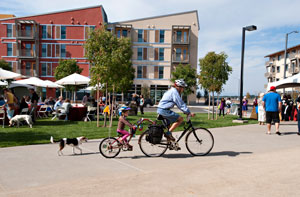University of California at Davis Project
 Enlarge image
Enlarge image
The village square, shown here, provides a center for activity and collaboration at the UC Davis West Village site. Photo by Karin Higgins/UC Davis
Through an innovative public-private partnership between the University of California at Davis (UC Davis) and the West Village Community Partnership, LLC, the West Village neighborhood will create numerous opportunities for more than 3,000 faculty, staff, and students to live locally and participate in the life of the campus through energy efficiency, renewable energy, and sustainability measures. The U.S. Department of Energy provided $2.5 million in funding for this Community Renewable Energy Deployment project.
Students began moving into the community's Viridian and Ramble apartments in August 2011. Nearly all the apartments are now leased, housing approximately 800 students, faculty, and staff. Single-family homes available for sale to staff and faculty are slated to be completed in late 2012.
The entire UC Davis West Village project is expected to be completed in fall 2013. When completed, West Village will include 662 apartments, 343 single-family homes, 42,500 square feet of commercial space, a recreation center, and study facilities.
Energy Efficiency and Sustainability Measures
West Village is on track to meet the California Energy Commission's Zero Net Energy Action Plan, which calls for shifting all new residential construction in California to zero net energy by 2020, and all new commercial construction by 2030.
To meet these aggressive energy goals, West Village will incorporate the following energy efficiency and sustainability measures:
- Solar-reflective roofing, radiant barrier roof sheathing, and extra insulation
- Energy-efficient exterior lighting fixtures, indoor occupancy sensors, and daylighting techniques
- A Web-based tool that enables residents to monitor their energy use, and a smart phone app that allows residents to turn off lamps and electronics remotely
- A biodigester based on technology developed at UC Davis, which will convert table scraps, animal, and plant waste from the campus into energy
- Drought-friendly landscaping, water-saving toilets, recycled building materials, and low volatile organic compound paints
- Sustainable transportation features, including a bike network and the student-run Unitrans bus service, which uses natural gas for power
- The uHub prototype—an incubator for innovation in sustainability, which will be located in commercial space surrounding the village square and will be home to the campus's energy research centers.
Environmental and Economic Benefits
The aggressive energy efficiency measures discussed above include a requirement that each building in the village be built better than code. Planners project these measures will reduce the campus' energy use by about 11 million kilowatt hours, or 50%, annually. Additional benefits include:
- More than 300 jobs created
- Rooftop PV installations over parking areas will meet the energy demands of the first 1,980 apartments and commercial spaces
- Creating a living laboratory that fosters interaction with the private sector on energy research.
What's more, in January 2012, Sacramento City College's Davis Center at UC Davis West Village opened, which is open to an estimated 2,400 students and is the first community college center housed on a UC campus.
Under the neighborhood master plan for UC Davis West Village, a future phase could include room for another 882 students and 132 single-family homes on acres. A timeline for this phase hasn't been set.
Learn more about the West Village project.
